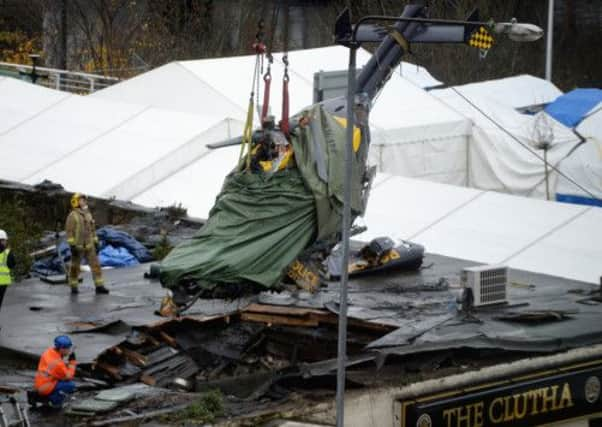Glasgow helicopter crash: No engine trouble - AAIB
This article contains affiliate links. We may earn a small commission on items purchased through this article, but that does not affect our editorial judgement.


The Air Accidents Investigation Branch (AAIB) said last night that “all significant components were present” at the time the two-engined Eurocopter EC135 helicopter crashed through the roof of the city’s Clutha bar on the night of 29 November.
But in a four-page bulletin recording the circumstances of the crash, the AAIB said that the main and tail rotors of the aircraft were not rotating when it struck the crowded pub in the city’s Broomie-law area. The report found the helicopter still had 95 litres of fuel when it crashed, killing its three crew and six people on the ground, and injuring 32 others.
Advertisement
Hide AdAdvertisement
Hide AdA former army helicopter pilot and aviation expert told The Scotsman the preliminary findings suggested the tragedy was a “one-off”, adding that the fact there was no fire suggested the helicopter could have suffered from fuel starvation, where fuel in the tank cannot pass through into the engines.
The publication of the findings came on the same day funerals were held for two of the victims of the accident, with two more funerals set to take place today.
The AAIB report stated: “Initial assessment provided no evidence of major mechanical disruption of either engine” which indicated the gearbox was functioning and providing drive from the second engine. Crash damage prevented inspectors from carrying out a “similar continuity check” on the craft’s first engine.
In a harrowing account of the chronology of the accident, the AAIB report said the Police Scotland helicopter had taken off at 8:45pm from Glasgow City Heliport with 400 kilograms of fuel on board. Visibility at the time was good, with light winds.
The helicopter stayed over an area of Glasgow’s southside for about 30 minutes before making a short ten-minute trip over Dalkeith in Midlothian, some 38 nautical miles away. It then returned to Glasgow.
The pilot, Captain David Traill, a two-decade veteran of the Royal Air Force who had served in both Gulf wars, was granted permission from air traffic controllers to re-enter Glasgow air space at 10:18pm.
However, no more was heard from Cpt Traill, 51, or his two crew members, Police Scotland constables Kirsty Nelis, 36, and Tony Collins, 43. They were killed along with six people inside The Clutha bar – Robert Jenkins, 61; Gary Arthur, 48; Mark O’Prey, 44; Colin Gibson, 33; John McGarrigle, 57; and Samuel McGhee, 56.
The AAIB report added: “No further radio transmissions from the pilot were received. Radar contact with the helicopter was lost at 22:22.
Advertisement
Hide AdAdvertisement
Hide Ad“Around this time the helicopter was seen and heard by a witness who described a noise like a loud ‘misfiring car’.”
Expanding on the account of the unidentified eyewitness, the report continued: “He then saw the helicopter descend rapidly. It crashed through the roof of The Clutha bar.”
Cpt Traill had significant flying experience, the AAIB report shows, having flown for more than 5,500 hours, including 646 hours behind the controls of the type of helicopter involved in the crash.
According to initial evidence, the Eurocopter struck the building “with a high rate of descent and low/negligible forward speed”. That echoes eyewitness reports following the accident, where one witness claimed the aircraft “dropped like a stone”.
The report added: “Preliminary examination showed that all main rotor blades were attached at the time of impact but that neither the main rotor nor the fenestron tail rotor were rotating.”
The helicopter, manufactured in 2007, suffered “very extensive damage”, but remained “approximately upright”. It had about 95 litres of fuel when it was removed from the crash site, the AAIB said.
Captain Phil Croucher, a former army helicopter pilot who has been flying since 1976, described the circumstances surrounding the crash as a rarity having read through the report.
He said: “It seems like this was a real one-off. The gearbox was capable of providing drive, which rules out the transmission. It had 95 litres of fuel, ten gallons per engine, which gave it 25 minutes of flying time, which is not at all an unusual amount to be going home with.”
Advertisement
Hide AdAdvertisement
Hide AdCpt Croucher, who is head of training for Caledonian Advanced Pilot Training in Troon, South Ayrshire, added: “The interesting thing is that a witness heard backfiring. If that’s related to an engine, it could mean that there was compressive surge, where the airflow is going round a jet engine the wrong way. But there is a titanium firewall between both engines and it would not necessarily have taken the other engine out, so that would have been very unusual.
“There was no fire, which suggests although there was fuel in the tank, it may not have been in the engines, with something blocking it somewhere on the way. I believe this particular helicopter is designed so that if one engine quits due to fuel starvation, the other engine quits two minutes later. There’s a delay in place which means both engines don’t quit at once.”
Investigators said they were continuing to carry out a “detailed examination” of the wreckage of the helicopter at the AAIB’s headquarters in Farnborough, Hampshire.
The bulletin added that the aircraft was not required to have, and was not fitted with, flight recorders, nor did its systems “provide a continuous recording of helicopter parameters”.
In a statement, the British Airline Pilots’ Association, said: “The information is a helpful first assessment and suggests there is no evidence of mechanical engine failure. But, unfortunately, at this stage, there is not much more to go on and the reasons behind the crash are far from clear. The AAIB must be given the time to complete its investigation.”
SEE ALSO